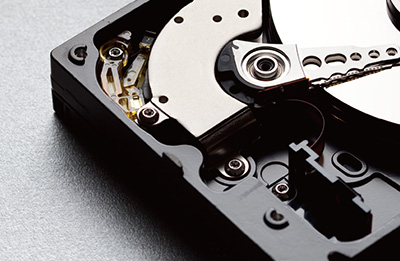HDD/SSD Erasing
Importance of Erasing

PCs and file servers used for work store a large amount of personal and confidential information on HDDs and various recording media. If corporate/individual users dispose of these recording media without knowledge, there is a risk that personal and confidential information may be leaked. Therefore, securely erasing data before media disposal is an extremely important issue for governments, medical institutions, financial institutions, and all companies and individuals that handle personal information. In particular, due to the characteristics of magnetic recording on HDDs, even if the data is physically destroyed by drilling holes without erasing the data, the data cannot be read out from the magnetic field remaining on the undamaged platters using advanced analysis equipment. Therefore, it is important to erase data beforehand even if physical destruction is to be performed.
Related link: Mistakes when erasing data - Data will not be deleted with that method!
Data Erasure and Reuse

There are two main types of erasing data on HDDs and recording media: logical erasing and physical erasing. (Erasure and physical destruction are separate processes, so their explanation will be omitted in this section.)
■ Logical erasure
This is a method used by the duplicator manufactured by U-Reach Data Solutions Inc., which overwrites the HDD containing data with hexadecimal 0x00 or random character strings, making the original data unreadable. HDD functionality is not lost, so it can be reused.
■ Physical erasure
By irradiating the HDD with a strong magnetic field and completely demagnetizing the magnetic force on the recording surface, data cannot be read. Because the magnetic field necessary to record data is lost, the HDD cannot be reused and must be discarded.
Standards for Complete Erasure

Different countries and industries have different standards for complete data erasure. Duplicators manufactured by U-Reach Data Solutions Inc. are highly reliable according to their standards and can erase data using an erasing method that is often used by companies. Additionally, some models allow erasing using even more reliable standards.
■ Complete erasure standard adopted by all duplicators manufactured by U-Reach Data Solutions Inc.
・One-time overwrite erasure according to NIST SP800-88r1 guidelines
・3-time overwrite erasure according to DoD 5220.22-M standard
About SSD Secure Erasure

To extend the lifespan of NAND flash, SSDs perform various internal processes such as transferring data to less frequently used blocks (cells) and preventing writes to frequently used blocks through wear leveling. Therefore, data written in all blocks may not be erased with one overwrite erase.
If you perform multiple erases, wear leveling may work against you and erase all blocks, but the more writes you perform, the more stress will be placed on the NAND flash, and it will wear out.
Secure erase of SSD erases SSD using the method specified by each SSD manufacturer. Since the secure erase program is written in the SSD's firmware, it is difficult to know what kind of erase is being performed, but it is generally recommended to disable wear leveling and erase all blocks. It has become. However, some SSDs perform their own processing and can complete the process in a short time.